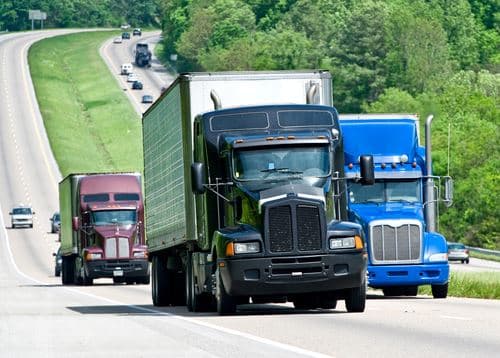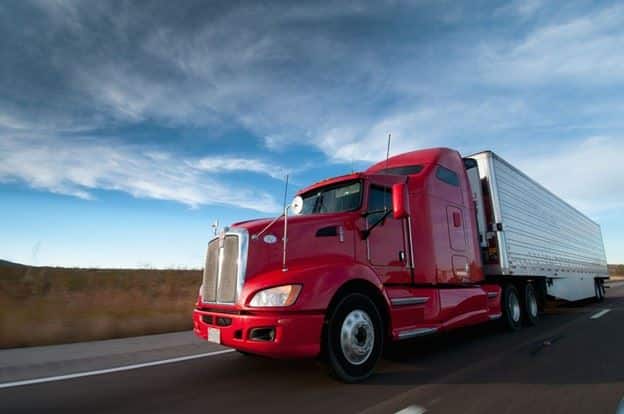Use These Simple & Effective Tips for Safely Driving Around 18-Wheelers & Minimizing Your Crash Risk

Big rigs are a mainstay on America’s roads. Transporting goods from point A to point B, 18-wheelers spend long hours on the roadways, making them almost unavoidable whenever you’re behind the wheel.
Given their large shape and heavier weights, commercial trucks can be uniquely risky, especially if you don’t know how to safely move around them.
To help you stay safe whenever you’re driving near or alongside a big rig, here are 10 essential safety tips for navigating the roads with semi-trucks. These are all easy things you can do to be proactive about safety while reducing your risk of an 18-wheeler wreck.
Driving Safety Tip # 1: Avoid the No Zones
The “no zones” are the truck’s blind spots. These are NOT the same as the blind spots on passenger vehicles. In fact, while cars have two blind spots (on their right and left sides), 18-wheelers have right- and left-side blind spots, as well as front and rear blind spots. Plus, these no zones for trucks are much larger than cars’ blind spots, as the table below highlights.

The best way to avoid these no zones is to make sure you can see the truck driver either directly or in the big rig’s mirrors. Whenever you can’t see the trucker, you should assume he can’t see you and that you’re in a no zone — and you should safely and quickly maneuver out of that no zone into a place where the truck driver CAN see you.
Driving Safety Tip # 2: Leave Plenty of Space

It’s no secret that tractor-trailers are some of the largest, heaviest vehicles on the road. What drivers can forget, though, is the fact that bigger trucks take more time and space to slow down and come to a full stop. Additionally, if trucks are traveling at higher speeds or if they have the less traction with the roads, they will need even more time and space to slow or stop.
So, do NOT tailgate or cut off tractor-trailers. While tailgating could lead to underride wrecks, darting in front of trucks too quickly can increase the risk of rear-end crashes, jackknife accidents, and other serious 18-wheeler wrecks. Also, remember to leave more space between your vehicle and a truck you’re following on a hill or slope in case a truck slightly rolls back (when trying to accelerate from a stopped position).
Driving Safety Tip # 3: Pass Safely
To safely pass a tractor-trailer:
- Check your mirrors and spacing first.
- Signal your intention to move into the left lane.
- When the path is clear, accelerate and maneuver the vehicle into the left lane, proceeding promptly and NOT lingering in the truck’s left-side blind spot.
- Verify that you see the truck in your rearview mirror and that you have sufficient space to safely pull in front of it. Only proceed when you have enough room to move in front of a truck without cutting it off or entering its front no zone.
Never attempt to pass an 18-wheeler:
- From the right lane, which has a much larger blind spot than the truck’s left-side no zone
- When traveling on downgrades, which can cause big rigs to speed up faster than smaller vehicles
If a semi-truck is attempting to pass you, reduce your speed to create extra space for the truck. Also, stay alert to the changing traffic conditions and stay to the right as the truck passes you.
Driving Safety Tip # 4: Expect Wider Turns
Just like trucks need extra room to slow down and stop, they also need more space to make turns. That’s because their long trailers need a larger turning radius, and those trailers do not follow the same turning path as the cabs. That can result in visibility limitations, right-side squeeze traps, and possibly trucks moving into intersections or other lanes of traffic.
So, anticipate these issues when you’re by big rigs that are making turns. Stay out of their way while they are turning, and be especially mindful of these turning differences in or around:
- Intersections
- Driveways and onramps
- Parking lots and parking garages
- Truck stops and gas stations
- Highway work zones
Driving Safety Tip # 5: Pay Attention & Stay Focused on the Road
Whether or not you’re sharing the roads with 18-wheelers, you should always be attentive to your surroundings and focused on safely navigating the roads. Still, it’s incredibly important to pay extra careful attention when you’re driving close to big rigs.
If you’re distracted and you end up in the wrong place at the wrong time, it could only take a few seconds for a horrific truck crash to occur.
Driving Safety Tip # 6: Never Drive While Impaired
Impairment can result from alcohol or drug use, as well as fatigue. No matter what causes it, driver impairment can give way to several problems, like:
- Risky driver decisions
- Loss of coordination
- Perception problems
- Delays in reaction times
- Passing out behind the wheel
Any of these issues can present major risks for drivers and anyone else on the roads with them. So, don’t get behind the wheel if you’re not sober or well rested.
Driving Safety Tip # 7: Always Wear Your Seatbelt
Seatbelts are one of the most effective pieces of safety equipment in cars, and it’s the easiest thing drivers can do to protect themselves — regardless of what happens on the roads. In fact, wearing seatbelts can save lives and reduce the severity of any injuries sustained if a wreck does occur.
According to authorities, in the event of a collision, buckling up cuts the risk of:
- Traffic deaths by 45%
- Non-fatal traffic accident injuries by 50%
So, buckle up and make sure your passengers wear their seatbelts. If you’re driving with younger children, be sure to properly restrain them too.
Conclusion: Roadway Safety Starts with You
You and every driver who gets behind the wheel of a car or truck plays a major role in roadway safety and crash prevention. If you commit to being a safe driver whenever you get behind the wheel, you’ll be doing a lot to reduce your risk of accidents, no matter who you share the roads with.









